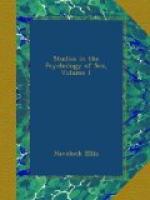[273] We might, perhaps, even say that in hysteria the so-called higher centres have an abnormally strong inhibitory influence over the lower centres. Gioffredi (Gazzetta degli Ospedali, October 1, 1895) has shown that some hysterical symptoms, such as mutism, can be cured by etherization, thus loosening the control of the higher centres.
[274] Charcot’s school could not fail to recognize the erotic tone which often dominates hysterical hallucinations. Gilles de la Tourette seeks to minimize it by the remark that “it is more mental than real.” He means to say that it is more psychic than physical, but he implies that the physical element in sex is alone “real,” a strange assumption in any case, as well as destructive of Gilles de la Tourette’s own fundamental assertion that hysteria is a real disease and yet purely psychic.
[275] See, e.g., his substantial volume, Die Traumdeutung, 1900, 2d ed. 1909.
[276] Sammlung, first series, p. 208.
[277] Studien ueber Hysterie, p. 217.
[278] Sammlung, first series, p. 162.
[279] Sammlung, second series, p. 102.
[280] Ib. p. 146.
[281] Sammlung, first series, p. 229. Freud has developed his conception of sexual constitution in Drei Abhandlungen zur Sexualtheorie, 1905.
[282] As Moll remarks, Freud’s conceptions are still somewhat subjective, and in need of objective demonstration; but whatever may be thought of their theories, he adds, there can be no doubt that Breuer and Freud have done a great service by calling attention to the important action of the sexual life on the nervous system.
[283] Gertrude Stein, “Cultivated Motor Automatism,” Psychological Review, May, 1898.
[284] Charcot’s most faithful followers refuse to recognize a “hysteric temperament,” and are quite right, if such a conception is used to destroy the conception of hysteria as a definite disease. We cannot, however, fail to recognize a diathesis which, while still apparently healthy, is predisposed to hysteria. So distinguished a disciple of Charcot as Janet thoroughly recognizes this, and argues (L’Etat mental, etc., p. 298) that “we may find in the habits, the passions, the psychic automatism of the normal man, the germ of all hysterical phenomena.” Fere held a somewhat similar view.
[285] A.F.A. King, “Hysteria,” American Journal of Obstetrics, May 18, 1891.
[286] M. Rosenthal, Diseases of the Nervous System, vol. ii, p. 44. Fere notes similar cases (Twentieth Century Practice of Medicine, vol. x, p. 551). Long previously, Gall had recorded the case of a young widow of ardent temperament who had convulsive attacks, apparently of hysterical nature, which always terminated in sexual orgasm (Fonctions du Cerveau, 1825, vol. iii, p. 245).
[287] There seems to be a greater necessity for such explosive manifestations in women than in men, whatever the reason may be. I have brought together some of the evidence pointing in this direction in Man and Woman, 4th ed., revised and enlarged, Chapters xii and xiii.




